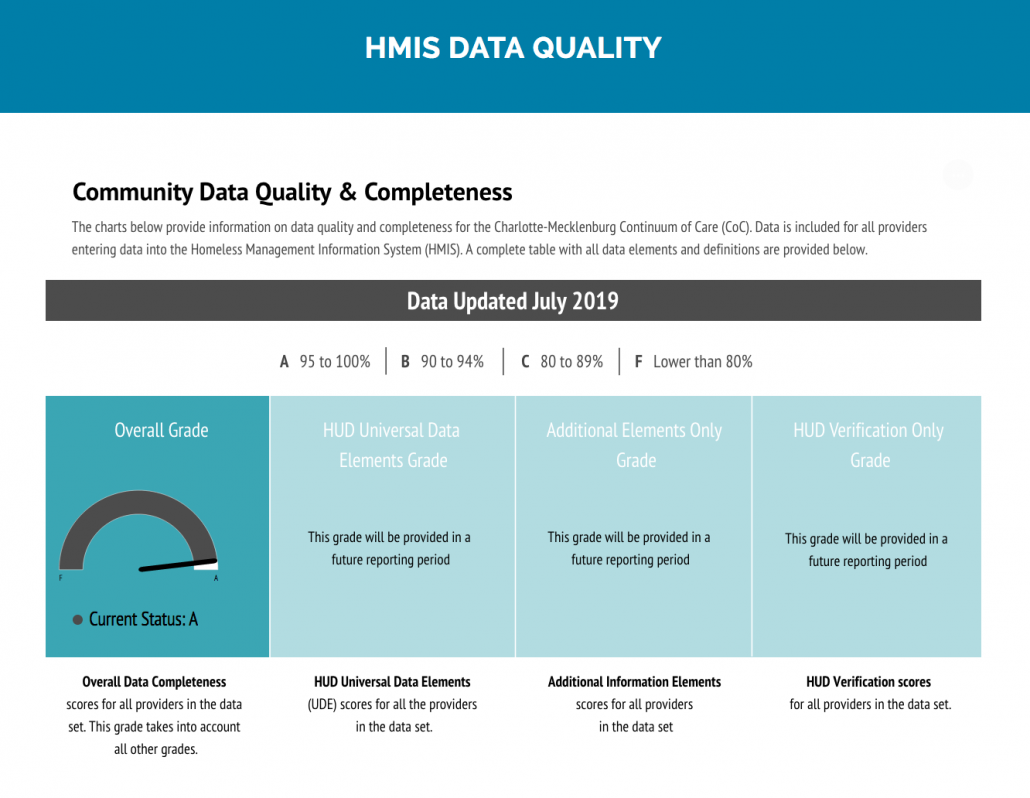Courtney Morton
Housing & Homelessness Research Coordinator
Mary Ann Priester
HMIS Administrator
Last week, the Building Bridges blog post described the community focus on and impact of HMIS data quality in Charlotte-Mecklenburg. As part of the work to improve local housing and homelessness data quality, Community Support Services created the HMIS Data Quality page on the Housing & Homelessness Dashboard.
This post is dedicated to the new HMIS Data Quality page launched today, Friday August 2nd. The page covers data quality as well as completeness for the Charlotte-Mecklenburg Continuum of Care (CoC). In addition, the post shares how this data can be employed and some potential impacts for Charlotte-Mecklenburg.
OVERALL GRADE
The “Overall Grade” provides a summary data completeness score for all information providers entering data in HMIS.
NEW ELEMENTS COMING
Three additional grades are included in the data quality and completeness scorecard: “Universal Data Elements” (UDE) provides a score on only the universal data elements, which are required for every HMIS provider; “Additional Elements Only” covers other data elements required of specific programs like Income and Health Insurance information; and “HUD Verification” refers to specific data elements collected when households enter a given program. These elements are listed in the chart at the bottom of the HMIS Data Quality page. Scores for each of these sections will be provided within the HMIS Data Quality dashboard in future reporting quarters.
DATA COMPLETENESS TABLE
The table located at the bottom of the HMIS Data Quality page lists all of the HMIS data elements collected and then evaluated for data quality and completeness. Here is a breakdown of what is included in the table and what each element means:
- “Required For:” Populations for which the data element is required to be reported (All, Adults, etc.). Some data elements are collected for all individuals, including children and youth; others may be collected on adults only. For example, birthdates are required for all individuals, but veteran status is only collected from adults.
- “Number of Applicable Entry Exits:” The number of people with entry exits for each data element. This represents the universe for each data element and is updated monthly. This number will be larger for the data elements that apply to “all” versus “adults” or “Head of Household.”
- “Number of Non-Null Values:” For each data element, the number of applicable entry exits with complete data.
- “Percentage Complete:” The number of non-null values divided by the number of applicable entry exits. The overall grades in the dashboard section of the HMIS Data Quality page are derived from combinations of these percentages.
SO, WHAT
In addition to the difficult, daily work of helping people find housing, staff at homeless and housing agencies also must complete the challenging task of collecting necessary information from people in the midst of a crisis. Front-line staff are trained to meet people where they are and explain the importance of obtaining complete and accurate information. However:
The data we can use is only as good as the data that we enter. By looking at the individual data elements and assessing how many client records have blank or inaccurate data indicates whether the data is reliable. If more people have missing or incomplete information, the less valid the data is for the community to draw conclusions about the populations served.
To facilitate accurate and timely data, it is important that our community establish benchmarks for data quality as well as implement a continuous improvement process. Charlotte-Mecklenburg has a dedicated group within the CoC called the “Data Quality Review Committee,” which regularly reviews data that is reported to the U.S. Department of Housing & Urban Development (HUD) as well as progress toward meeting our community-generated benchmarks.
It is also critical for agencies to regularly review their own program-level data for data quality and completeness. This process can only improve program and participant outcomes. For example, one agency ran its HMIS Data Quality & Completeness Report and found that. by simply updating their missing exit data, their permanent housing exit outcomes improved. This simple, cost-effective step meant that the agency avoided making more costly and time intensive staff and/or programmatic changes. Equipped with accurate data, the agency now knows where to target change efforts.
Knowing our data is good is key to using our data for good.
Courtney Morton coordinates posts on the Building Bridges Blog. Courtney is the Housing & Homelessness Research Coordinator for Mecklenburg County Community Support Services. Courtney’s job is to connect data on housing instability, homelessness and affordable housing with stakeholders in the community so that they can use it to drive policy-making, funding allocation and programmatic change.


